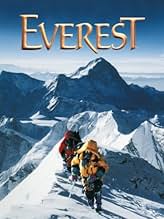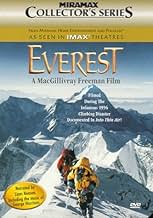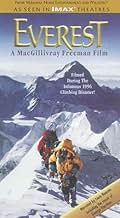Agrega una trama en tu idiomaAn international team of climbers ascends Mt. Everest in the spring of 1996. The film depicts their lengthy preparations for the climb, their trek to the summit, and their successful return ... Leer todoAn international team of climbers ascends Mt. Everest in the spring of 1996. The film depicts their lengthy preparations for the climb, their trek to the summit, and their successful return to Base Camp. It also shows many of the challenges the group faced, including avalanches, ... Leer todoAn international team of climbers ascends Mt. Everest in the spring of 1996. The film depicts their lengthy preparations for the climb, their trek to the summit, and their successful return to Base Camp. It also shows many of the challenges the group faced, including avalanches, lack of oxygen, treacherous ice walls, and a deadly blizzard.
- Dirección
- Guionistas
- Elenco
- Premios
- 1 premio ganado y 1 nominación en total
- Narrator
- (voz)
- Geologist
- (sin créditos)
- Helicopter Pilot
- (sin créditos)
- Documenter, Middle Camp Radio Contact
- (sin créditos)
- Dirección
- Guionistas
- Todo el elenco y el equipo
- Producción, taquilla y más en IMDbPro
Opiniones destacadas
People who have said they are interested in seeing the story of the Sherpas or how the movie was made should check out the special features on the DVD, Broughton Coburn's book "Everest," or Jamling Norgay's book "Touching My Father's Soul"; they are all about the climb, Norgay especially devotes time and pages to the Sherpas, considering he is also ethnically a Sherpa, who someone mistakenly said were Tibetan; in fact they are Nepalese.
This was an interesting movie in its own right. I don't understand why some reviewers did not enjoy the back stories and time devoted to the climbers' emotions and personal lives...would you rather watch a movie about people you didn't empathise with, care about, or even know? I do not think so. Developing the characters of the lead climbers was very important to the movie, I felt.
Also, insulting Ed Viesturs is just incomprehensible to me. He is the prominent North American mountaineer of our times, and since the movie was made has ascended all 14 8000 meter peaks without the use of oxygen, a climbing skill he has acquired over many years and excels at. He doesn't do so because he 'likes the challenge' as one reviewer says, but merely because he feels it is a better way of climbing. It should be noted that whenever Viesturs guides mountains he uses oxygen so he can 'be there' for his clients. Viesturs did not have to coerce his wife into coming to Base Camp; she'd been on the mountain before and I believe enjoyed the atmosphere and the climbers. She was worried, of course, about Ed, but since he really had no one to worry about but himself, and I don't think anyone can dispute that Edmund Viesturs can take care of himself, she trusted him to return safely. (There would have been a considerably lower death rate on the mountain if only experienced climbers looking after themselves had climbed that season.) Ed Viesturs WAS a hero of the movie, although he is extremely humble about it, he did considerably assist in the rescue of Makalu Gau and Beck Weathers, as well as coordinating rescue attempts from Camp II, and I have no doubts that had Viesturs been at Camp IV on May 10/11, he would have climbed up and searched for missing climbers himself (most likely using oxygen). If you are not a professional climber yourself, I do not think you have the right to insult the personal practices of a mountaineer like Viesturs, especially when his choices (such as using or not using oxygen) affect, in the long run, only himself, as he was not guiding the peak or responsible for any other climbers at the time.
I loved the movie; every time I see it I get chills at the stunning Breashears images of the mountain.
I definitely recommend seeing this movie. It represents both the darker, dangerous side of mountaineering and the light, triumphant side.
PS: The DVD version contains lots of good supplementary material, in fact, the `making of the film'
There are some good shots of the IMAX expedition's trek up to the base camp. Then "Everest" follows the climbers through the ice fall to their middle camp. The jewel case informs readers that "Everest" was "Filmed During The Infamous 1996 Climbing Disaster Documented in Into Thin Air." To some this might suggest that the film is about the 1996 disaster. But, when planning their expedition, the IMAX producers did not know there would be a disaster. They wanted to document a climb to the summit, and just happened to be on the mountain when the disaster occurred. The film does offer a six-minute interlude about the disaster; and this is appropriate, because some members of the IMAX expedition participated in the rescue efforts. But there is no original footage of the storm, during which visibility was virtually nil. The film's final eleven minutes take viewers to the top of the mountain. There are some spectacular views of the mountain and its surroundings; but these do not adequately exploit the wide-angle panoramic potential that is the special strength of IMAX photography. In a decision symptomatic of the film's unfortunate priorities, on breathtaking views from the summit, the producers chose to superimpose snapshots of the climbers panoplied in climbing suits that concealed both their identities and their emotions.
In a sense, the extras are better than the feature. This is especially true of "The Making of Everest," a 37-minute segment that explains how the movie was made. In this, we learn about the logistical implications of IMAX photography. A frame of film exposed by an IMAX camera is ten times as large as that exposed by a traditional 35mm film camera. IMAX cameras consume film at the astronomical rate of 360 feet per minute—a 500-foot reel yields only 90 seconds of film. Since the customary 100-pound IMAX camera was unsuitable for "Everest," engineers designed a compact 40-pound version specially constructed to withstand the cold. Four sherpas had the task of getting the camera gear up the mountain—separately assigned to carry the camera, the tripod, the film, and the batteries and other accessories. In order to film, the camera crew had to prepare special landings for the tripod, set up all the equipment, and load the film. Only tremendous effort and favorable weather enabled the IMAX expedition to succeed in their venture. But this was not "Candid Camera"—with this technology, there could be no close-up pictures of a climber ascending the Hillary Step.
"Everest" provides five minutes of footage that was omitted from the main feature. This is presented with music, but without commentary. Given the costs and technical requirements of IMAX photography, all the filming was carefully planned. And some omitted shots are so good one wonders why they were not used. There are also the Climbers' Video Journals, in which Segarra, Norgay, and Viesturs discuss their climbing experiences. Without doubt, the most gripping of the extras are the 36 minutes of outtakes from what must have been a lengthy interview of Beck Weathers, the Texas physician who lost both of his hands to frostbite during the 1996 storm. Weathers describes his reasons for climbing and its dangers; and offers his perspective on 1996, especially on his own nearly miraculous survival.
This is a good film; but it would have been improved with more panoramic shots.
¿Sabías que…?
- TriviaA huge blizzard hit Mt. Everest during filming. Eight people died, and nearly two dozen were trapped on the mountain. The blizzard and its aftermath are the basis for Into Thin Air: Death on Everest (1997). Expedition members interrupted filming to aid the stricken climbers.
- Citas
Paula Viesturs: The difference between me and Ed is... when we go for a 5-hour bike ride, I call it a workout. He calls it a warm-up.
- Bandas sonorasHere Comes the Sun
Written by George Harrison
Selecciones populares
Detalles
- Fecha de lanzamiento
- País de origen
- Sitios oficiales
- Idioma
- También se conoce como
- Everest, entre la gloria y la tragedia
- Locaciones de filmación
- Productoras
- Ver más créditos de la compañía en IMDbPro
Taquilla
- Total en EE. UU. y Canadá
- USD 87,178,599
- Fin de semana de estreno en EE. UU. y Canadá
- USD 364,244
- 8 mar 1998
- Total a nivel mundial
- USD 127,990,128
- Tiempo de ejecución44 minutos
- Color
- Mezcla de sonido
- Relación de aspecto
- 1.44 : 1
Contribuir a esta página
























